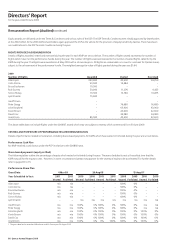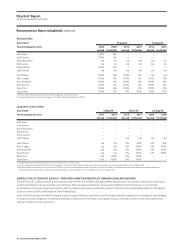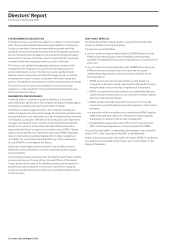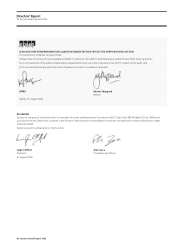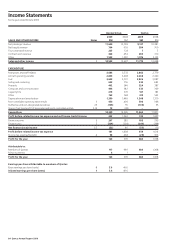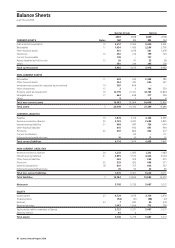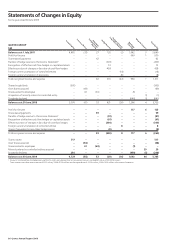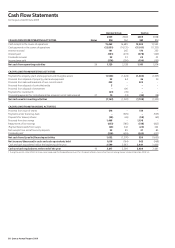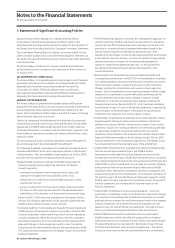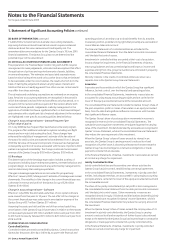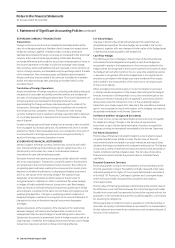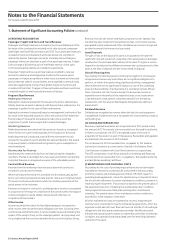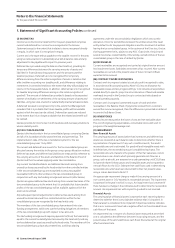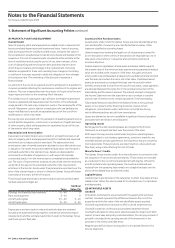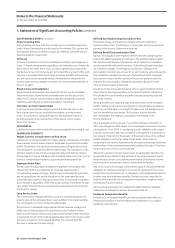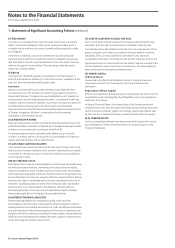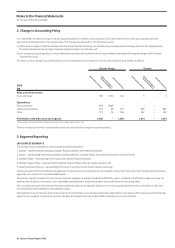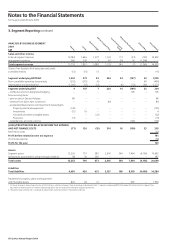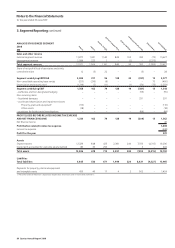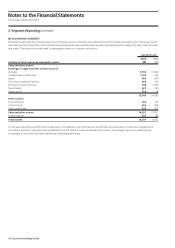Qantas 2009 Annual Report Download - page 92
Download and view the complete annual report
Please find page 92 of the 2009 Qantas annual report below. You can navigate through the pages in the report by either clicking on the pages listed below, or by using the keyword search tool below to find specific information within the annual report.
90 Qantas Annual Report 2009
Notes to the Financial Statements
for the year ended 30 June 2009
1. Statement of Significant Accounting Policies continued
(B) BASIS OF PREPARATION continued
•AASB2009-2AmendmentstoAustralianAccountingStandards–
Improving Disclosures about Financial Instruments requires enhanced
disclosures about fair value measurements and liquidity risk. The
amendments become mandatory for the Qantas Group’s 30 June 2010
financial statements. The Qantas Group has not yet determined the
potential impact of the amendment.
(C) CRITICAL ACCOUNTING ESTIMATES AND JUDGEMENTS
The preparation of a Financial Report conforming with AASBs requires
management to make judgements, estimates and assumptions that affect
the application of policies and reported amounts of assets, liabilities,
income and expenses. The estimates and associated assumptions are
based on historical experience and various other factors that are believed
to be reasonable under the circumstances, the results of which form the
basis of making the judgements about carrying values of assets and
liabilities that are not readily apparent from other sources. Actual results
may differ from these estimates.
The estimates and underlying assumptions are reviewed on an ongoing
basis. Revisions to accounting estimates are recognised in the period in
which the estimate is revised if the revision affects only that period, or in
the period of the revision and future periods if the revision affects both
current and future periods. Judgements made by management in the
application of AASBs that have a significant effect on the Financial Report
and estimates with a significant risk of material adjustment in the next year
are highlighted in the specific accounting policies detailed below.
Change in accounting estimates – Qantas Frequent Flyer
(i) Fair value of points
On 1 July 2008 Qantas Frequent Flyer launched an enhanced program.
This program offers additional redemption options including non-flight
awards and non-restricted seating (Any Seat). These changes have
enhanced the reliability of management’s estimate of the fair value of
the award for which points are expected to be redeemed. From 1 January
2009 the fair value of the award component of revenue has changed and
consequently a portion of revenue associated with the sale of points to third
parties is recognised immediately. The change in estimate has increased
revenue of the Qantas Group by $193 million (Qantas: $193 million).
(ii) Breakage
The determination of the breakage expectation includes a variety of
assumptions including future redemption patterns, member behaviour and
program design. Actuarial assessments are performed by management to
assist in determining the breakage expectation.
Changes in breakage expectations are accounted for prospectively.
Effective 1 January 2009, Management’s estimate of breakage was revised
downwards. The net effect of the change in the current financial year was
a decrease in revenue and profit of the Qantas Group of $29 million
(Qantas: $36 million).
Change in accounting estimate – Sof tware
Effective 1 July 2008, the estimated useful lives of core system software
were revised from five years to 10 years. The net effect of the changes in
the current financial year was a decrease in amortisation expense of the
Qantas Group of $17 million (Qantas: $17 million).
Assuming the assets are held until the end of their revised useful lives,
amortisation of the Qantas Group in future years in relation to these assets
will decrease by between $10 million and $26 million each year from 2010
to 2013 and increase by between $15 million to $20 million each year from
2014 to 2018.
(D) PRINCIPLES OF CONSOLIDATION
Controlled Entities
Controlled entities are entities controlled by Qantas. Control exists when
Qantas has the power, directly or indirectly, to govern the financial and
operating policies of an entity so as to obtain benefits from its activities.
In assessing control, potential voting rights that presently are exercisable or
convertible are taken into account.
The Financial Statements of controlled entities are included in the
consolidated Financial Statements from the date that control commences
until the date that control ceases.
Investments in controlled entities are carried at their cost of acquisition,
less any charge for impairment, in the Financial Statements of Qantas.
Intra-group balances and any unrealised gains and losses or income and
expenses arising from intra-group transactions are eliminated in preparing
the consolidated Financial Statements.
Minority interests in the results of controlled entities are shown as a
separate item in the Qantas Group Financial Statements.
Associates
Associates are those entities in which the Qantas Group has significant
influence, but not control, over the financial and operating policies.
In the consolidated Financial Statements, investments in associates are
accounted for using equity accounting principles and are carried at the
lower of the equity accounted amount and the recoverable amount.
The consolidated Financial Statements include the Qantas Group’s share of
the post-acquisition profits or losses of associates on an equity accounted
basis, from the date that significant influence commences until the date
that significant influence ceases.
The Qantas Group’s share of post-acquisition movements in reserves is
recognised in reserves in the consolidated Financial Statements. The
cumulative post-acquisition movements are adjusted against the carrying
value of the investment. Dividends declared by associates are recognised in
Qantas’ Income Statement, while in the consolidated Financial Statements
they reduce the carrying amount of the investment.
When the Qantas Group’s share of losses exceeds its interest in an
associate, the Qantas Group’s carrying amount is reduced to nil and
recognition of further losses is discontinued except to the extent that the
Qantas Group has incurred legal or constructive obligations or made
payments on behalf of an associate.
In the Financial Statements of Qantas, investments in associates are carried
at cost less any charge for impairment.
Jointly Controlled Entities
Jointly controlled entities are those entities over whose activities the
Qantas Group has joint control, established by contractual agreement.
In the consolidated Financial Statements, investments in jointly controlled
entities, including partnerships, are accounted for using equity accounting
principles and are carried at the lower of the equity accounted amount and
the recoverable amount.
The share of the jointly controlled entity’s net profit or loss is recognised in
the consolidated Income Statement from the date joint control commences
until the date joint control ceases. Other movements in reserves are
recognised directly in equity. Dividends and distributions declared by jointly
controlled entities are recognised in Qantas’ Income Statement, while in
the consolidated Financial Statements they reduce the carrying amount of
the investment.
When the Qantas Group’s share of losses exceeds the carrying value of its
investment in a jointly controlled entity, the Qantas Group’s carrying
amount is reduced to nil and recognition of further losses is discontinued
except to the extent that the Qantas Group has incurred legal or constructive
obligations or made payments on behalf of a jointly controlled entity.
In the Financial Statements of Qantas, investments in jointly controlled
entities are carried at cost less any charge for impairment.


